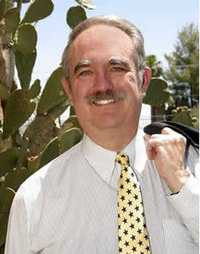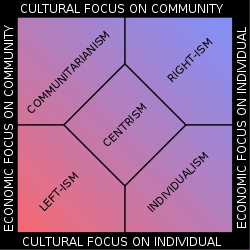Nolan Chart

The Nolan Chart is a political view assessment diagram created by American politician David Nolan. The chart divides human political opinions into two vectors – economic opinion and personal opinion – to produce a type of Cartesian chart. The chart illustrates the libertarian view of economic and personal freedom. It expands the "left-right" line which attempted to measure politics along a one-dimensional line into a graph with two dimensions: degrees of economic and social freedom.
Development

A similar bi-dimensional chart appeared during 1970 in the publication The Floodgates of Anarchy[1] by Stuart Christie and Albert Meltzer. Their version had "anarchism" in the equivalent of the Nolan Chart's Left-Wing corner, "fascism" in the equivalent of the Nolan's Right-Wing corner, "capitalist individualism" in the equivalent of the Nolan's Libertarian corner and "state communism" in the equivalent of the Nolan's Populist (Totalitarian) corner. In Radicals for Capitalism (p. 321), Brian Doherty traces the idea for the chart to an article by Maurice Bryson and William McDill in The Rampart Journal of Individualist Thought (Summer 1968) entitled "The Political Spectrum: A Bi-Dimensional Approach".
David Nolan first published the current version of the chart in an article named "Classifying and Analyzing Politico-Economic Systems" in the January 1971 issue of The Individualist, the monthly magazine of the Society for Individual Liberty (SIL). In December 1971, he helped to start the group that would become the Libertarian Party.[2]
Frustrated by the "left-right" line analysis that leaves no room for other ideologies, Nolan devised a chart with two axes in 1969 which would come to be known as the Nolan Chart. The Nolan Chart is the centerpiece of the World's Smallest Political Quiz.
Nolan's insight was that the major difference between various political philosophies, the real defining element in what a person believes politically, is the amount of government control over human action that is advocated.
Nolan further reasoned that virtually all human political action can be divided into two broad categories: economic and personal.
The "economic" category includes what people do as producers and consumers – what they can buy, sell, produce. Where they work, who they hire, what they do with their money. Examples of economic activity: starting a business; buying a home; constructing a building; working in an office.
The "personal" category includes what people do in relationships, in self-expression, and in general what they do with their own bodies and minds. Examples of personal activities: marriage; choosing what books they read and movies they watch; what foods, medicines, and drugs they choose to consume; sports; their religious choices; organizations they join; with whom they choose to associate.
Since, Nolan realized, most government activity (or government control) occurs in these two major areas, political positions can be defined by how much government control a person favors in these two areas. The extremes are no government at all in either area (anarchism) or total or near-total government control of everything (various forms of totalitarianism).

Most political philosophies fall somewhere in between. In broad terms:
- Conservatives and those on the right tend to favor more freedom in economic areas (example: a free market), but more government intervention in social areas (example: drug laws).
- Liberals and those on the left (by the common US meanings of those terms) tend to favor more freedom in personal areas (example: no military draft), but more government activism or control in economics (example: a government-mandated minimum wage).
- Libertarians favor both personal and economic freedom, and oppose most (or all) government intervention in both areas. Like conservatives, libertarians believe that people should be free to make economic choices for themselves. Like liberals, libertarians believe in personal freedom.
- Statists favor a lot of government control in both the personal and economic areas. Several versions of the chart, as well as Nolan's original chart, use different terms such as 'communitarian' or 'populist'.
Of course, liberals, conservatives, and others may disagree among themselves on particular issues, and hold different positions. Examples: a liberal might be opposed to censorship and draft, but want to continue the Drug War and end the minimum wage. Or a conservative may oppose censorship and the draft, but favor restricting free trade. But the broad division generally holds true.
Another way of expressing this (a sort of "libertarian-centric" view): conservatives tend to be more libertarian on economic issues; liberals tend to be more libertarian on issues of personal freedom.
In order to visually express this insight, Nolan came up with a two-axis graph. One axis was for economic freedom, and the other was for personal freedom.
Once both areas were on a graph, it was possible to put a scale on each of the two axes of that graph. Nolan's scale started at zero (total state control) to 100% (no state control). 100% in economics would mean a free market; 100% in personal issues would mean no government control in private, personal life.
By using the scale on each of the two axes, it was possible to measure the amount of personal liberty and economic liberty a person, political organization, or political philosophy advocates, and then plot that on the graph.
Thus, while the old "left-right" line attempted to measure politics along a one-dimensional line, Nolan's graph divided political issues into two dimensions: economic and social.
So, instead of classifying all political opinion as being some variant of liberal or conservative, Nolan's chart allowed a far more accurate measurement: how much (or little) government control a person favored in personal and economic matters.
Nolan introduced his chart in an article entitled "Classifying and Analyzing Politico-Economic Systems" published in the January 1971 issue of The Individualist, a libertarian newsletter.
Nolan said that one of the impacts of his chart is that to someone who views it it causes an irreversible change....that viewers will view the included orientations in two dimensions instead of one.[3]
In 1987, Marshall Fritz, founder of the Advocates for Self-Government, tweaked the chart and added ten questions – which he called the World’s Smallest Political Quiz – which enabled people to plot themselves on the chart and discover where they fit on the political map.
Positions

Differing from the traditional "left/right" distinction and other political taxonomies, the Nolan Chart in its original form has two dimensions, with a horizontal x-axis labeled "economic freedom" and a vertical y-axis labeled "personal freedom". It resembles a square divided into four quadrants, with each sample in the population assigned to one of the quadrants:
- Bottom left – Left-Wing Political Philosophies. Those supporting low economic freedom and high personal freedom.
- Top right – Right-Wing Political Philosophies. Those supporting high economic freedom and low personal freedom.
- Bottom right – Libertarianism. David Nolan's own ideology, corresponding with those supporting high economic and personal freedom.
- Top left – Statism The opposite of libertarianism, corresponding with those supporting low economic and personal freedom. David Nolan originally termed this philosophy populism, but many later renditions of the chart have used the label statism, authoritarianism, totalitarianism, or fascism instead. Many libertarian groups have labeled that section as communitarianism.
Polling
In August 2011, the libertarian Reason Magazine worked with the Rupe organization to survey 1,200 Americans by telephone and place their views within Nolan chart based categories. The Reason-Rupe poll found that "Americans cannot easily be bundled into either the 'liberal' or 'conservative' groups". Specifically, 28% expressed conservative views, 24% expressed libertarian views, 20% expressed communitarian views, and 28% expressed liberal views. The margin of error was ±3.[4]
A similar Gallup survey in 2011 included a centrist/moderate group. That poll reported that 17% expressed conservative views, 22% expressed libertarian views, 20% expressed communitarian views, 17% expressed centrist views, and 24% expressed liberal views.[4]
See also
- Political Compass
- Political spectrum
References
- ↑ Christie, Stuart, Albert Meltzer. The Floodgates of Anarchy. London: Kahn & Averill, 1970. ISBN 978-0-900707-03-2
- ↑ "David Nolan – Libertarian Celebrity". Advocates for Self Government. Archived from the original on 2008-06-16. Retrieved 2008-09-09.
- ↑ "Mark Selzer and co-host Martina Slocomb interview David Nolan". The Libertarian Alternative Public Access TV Show. Retrieved February 15, 2013.
- ↑ 4.0 4.1 Ekins, Emily (August 29, 2011). "Reason-Rupe Poll Finds 24 Percent of Americans are Economically Conservative and Socially Liberal, 28 Percent Liberal, 28 Percent Conservative, and 20 Percent Communitarian". Reason Magazine. Retrieved January 1, 2012.
Further reading
- Bryson, Maurice C.; McDill, William R. (Summer 1968). "The Political Spectrum: A Bi-Dimensional Approach". Rampart Journal of Individualist Thought (Larkspur, CO: Rampart College) IV: 19–26.
External links
Template:Commonscéat
- A modern version of the Nolan Chart
- Nolan Chart website
- The Nolan Chart and its variations
- Positive & Negative Liberties in Three Dimensions
- The Enhanced Precision Political Quiz... IN 2D
- Political Profile Test
- Political Spectrum Quiz
- A voting index of the U.S. Congress (prepared by Prof. Clifford F. Thies for the Republican Liberty Caucus.)
| |||||